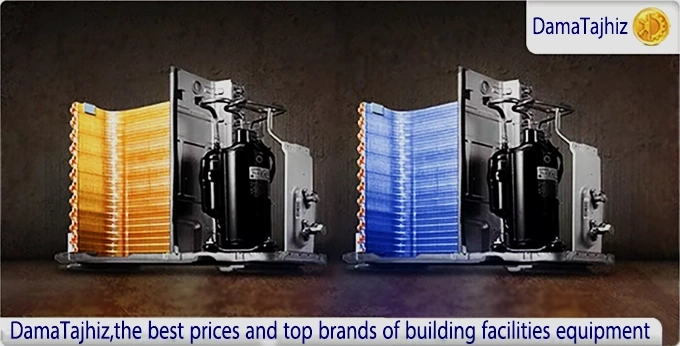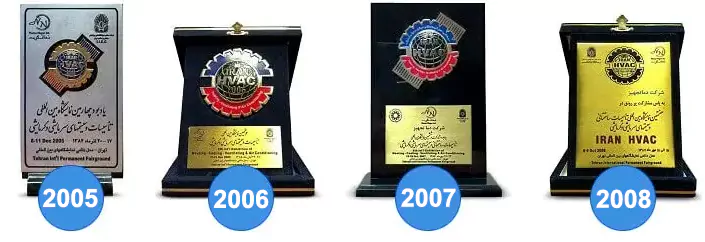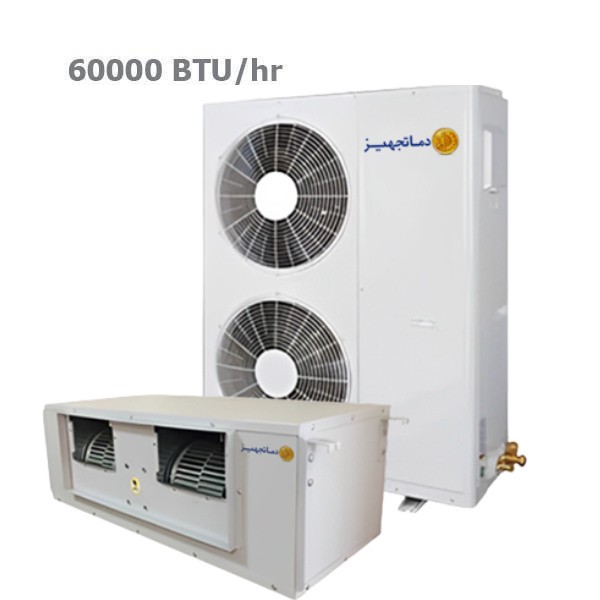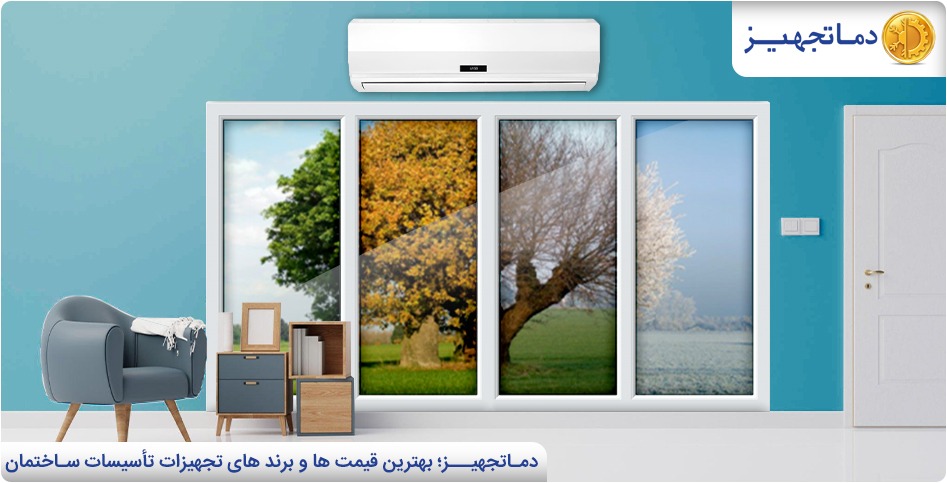The condenser coil and the evaporator in heat exchangers play a vital role in the refrigeration cycle. To increase the heat transfer rate from the surface of the condenser coil, thin ribs known as fins are installed at specific intervals along the coil’s surface. These fins come in two main types as Blue Fins and Gold Fins.
However, coils and fins are constantly exposed to adverse weather conditions, especially in humid environments (such as Rasht, Ramsar, Zahedan, Chabahar, Bandar Abbas, Abadan, Ahvaz, Kish, Dubai, Sharjah, Basra, Baghdad, Damascus, Beirut, Doha, Muscat, Kuwait, and others). These areas also often contain acidic and salty compounds in the rainwater, which can damage the coils and fins over time, resulting in irreparable financial losses and reduced system efficiency in the long run.
One effective way to prevent the corrosion and deterioration of coils and fins in evaporators and condensers of air conditioning systems in such environments is to use Blue Fin and Gold Fin coating technologies, which we will explore in this article. Please stay with us.
This blog post reviews the essence of blue and golden fins, blue fin vs gold fin thoroughly, and in a brief table; and after all, you will see the advantages of using gold fin vs blue fin in AC and other HVAC systems.

What is Blue Fin?
Blue Fin technology refers to an epoxy resin coating applied to the condenser coil and evaporator in HVAC equipment such as air conditioners, split AC units, ducted split systems, fan coil units, etc. The blue fin coating is highly resistant to moisture, chemical environments, and solvents. As the name suggests, the coating is blue.
Blue Fin condenser is commonly used in acidic environments (with acid vapors, such as in industrial areas) and high-humidity locations (like the southern and northern cities of Iran or other previously mentioned cities) to prevent rust and corrosion on the coils and fins of both the condenser and evaporator.
Because the Blue Fin coating has very low surface tension, it reduces the accumulation of water droplets formed from condensation at the evaporator’s dew point, further protecting the coil from rust and erosion.

What is Gold Fin?
Gold Fin is a nano-gold-coated coil surface. Its function is similar to that of Blue Fin and is also used in corrosive and erosive environments where there is moisture, water droplets, salts, and acid vapors. However, Gold Fin has the added advantage of performing well in reverse cycles, meaning it remains effective when the system is used for heating and cooling.
Additionally, Golden Fin has a higher heat exchange rate than Blue Fin; this feature improves the unit’s efficiency during heating by enhancing heat transfer in the condenser coil.
Due to its relatively higher cost, Gold Fin is used less frequently than Blue Fin. However, when both heating and cooling functionalities are required, the use of Gold Fin on the unit’s coil becomes necessary.

What are Blue Fin Condenser and Gold Fin Condenser?
Gold Fin and Blue Fin are two types of protective coatings applied to condenser coils in HVAC systems. Blue Fin condenser uses hydrophilic materials that absorb water, making it suitable for mild climates but offering less corrosion resistance. Gold Fin, with its hydrophobic coating that repels water, provides better protection against corrosion and extends the system’s lifespan, making it ideal for harsh environments or systems that operate year-round. While Golden Fin is more expensive, it offers better durability and long-term efficiency. Blue Fin is a good option if you're on a budget and the system is used in mild conditions, but Gold Fin is the preferred choice for better performance and longevity.
Blue Fin Condenser
Blue Fin condensers are designed with a hydrophilic coating that helps the aluminum fins absorb water, making them more resistant to corrosion caused by moisture and environmental elements. This coating is highly effective in regions with moderate humidity and is a more affordable option for systems used in mild climates. While Blue Fin enhances heat transfer efficiency, it may not offer the same level of protection as Gold Fin in harsher environments. It’s perfect for budget-conscious users who don’t need top-tier corrosion resistance or year-round system use.
These condensers are commonly found in standard HVAC systems, including aircon and split units, where performance requirements aren’t as demanding. While the condensers offer a solid balance between affordability and efficiency, they might not last as long in corrosive conditions compared to their Gold Fin counterparts.
Gold Fin Condenser
On the other hand, Gold Fin condensers feature a hydrophobic coating that repels water, providing superior protection against corrosion from salt, humidity, and environmental contaminants. This coating is particularly useful in coastal areas or places where the system runs throughout both cooling and heating seasons. Gold Fin condensers are built to withstand harsher conditions, offering better longevity and higher heat transfer efficiency over time.
Though Golden Fin units come at higher prices, the investment is worth it for systems that demand durability and performance. The advanced protection and efficiency make them the best choice for high-performance systems or installations in corrosive environments. Gold Fin condensers are ideal for users looking for long-term value and optimal heat exchange efficiency in both heating and cooling applications.
Review, Selection, and Pricing of HVAC Equipment
Gold Fin vs Blue Fin
Blue Fin and Gold Fin are two types of protective coatings applied to the fins of heat exchangers (such as condensers and evaporators) in HVAC systems. While both serve the same core purposes—enhancing corrosion resistance, improving heat transfer efficiency, and extending equipment lifespan—they differ in terms of material composition, protective properties, durability, and ideal applications.
Blue Fin Coating
Blue Fin coating is a protective layer applied to HVAC system coils, designed to enhance efficiency and prolong longevity in moderate environmental conditions. This coating utilizes hydrophilic compounds that help reduce moisture retention, providing moderate protection against corrosion and enhancing heat transfer performance.
- Material: Made with hydrophilic compounds (water-attracting), Blue Fin coatings are designed to allow water to spread evenly and drain quickly from coil surfaces, reducing moisture retention.
- Corrosion Resistance: Offers moderate protection against corrosion from environmental elements such as humidity and salt, making it suitable for less aggressive climates.
- Heat Transfer Efficiency: Improves the performance of the heat exchanger by facilitating better interaction between air and refrigerant.
- Durability: Durable enough for standard environmental conditions, but less robust than Gold Fin in harsh environments.
- Color: Despite the name, the coating is not necessarily blue; the term refers to the hydrophilic nature of the coating.
- Advantages: More cost-effective, adequate for mild climates and mid-range systems.
- Disadvantages: Lower corrosion resistance and shorter lifespan compared to Gold Fin.
Gold Fin Coating
Gold Fin coating offers superior protection for HVAC system coils, utilizing hydrophobic compounds that effectively repel water and reduce the accumulation of contaminants. It is ideal for harsh environments where corrosion and moisture are a concern, providing enhanced durability and performance.
- Material: Uses hydrophobic compounds (water-repelling), which prevent water droplets from clinging to the surface, reducing the risk of corrosion and dirt buildup.
- Corrosion Resistance: Provides superior protection against rust and chemical damage, especially effective in coastal or industrial environments with high humidity and salinity.
- Heat Transfer Efficiency: Enhances system efficiency by maintaining cleaner coils and ensuring unobstructed airflow and thermal conduction.
- Durability: Known for long-lasting performance in extreme and corrosive environments.
- Color: Often has a golden or yellowish appearance, but this may vary by manufacturer.
- Advantages: Higher corrosion resistance, better heat transfer, extended durability.
- Disadvantages: Typically, more expensive than Blue Fin.
Gold Fin vs Blue Fin, Which Is Better?
If you want to find out which of the gold and blue fins is better, the following table reviews the main differences between Gold Fin and Blue Fin.
| Factor | Blue Fin | Gold Fin |
|---|---|---|
| Material | Hydrophilic (water-attracting) | Hydrophobic (water-repelling) |
| Corrosion Resistance | Moderate | High |
| Durability | Good | Excellent |
| Heat Transfer | Improved | More efficient |
| Ideal Usage | Mild climates | Harsh, coastal, or corrosive environments |
| Cost | Lower | Higher |
| Best for | Cooling-only systems | Systems with both cooling and heating |
Blue Fin vs Gold Fin in Brief
Blue Fin and Gold Fin coatings provide essential protection for HVAC systems, enhancing their efficiency and lifespan. Blue Fin is an excellent choice for budget-conscious users in mild climates, offering solid corrosion protection at an affordable price. On the other hand, GoldFin offers superior corrosion resistance, better heat transfer, and higher durability, making it the preferred choice for users requiring top performance in harsh or year-round operating conditions.
- Choose Gold Fin if your HVAC system operates in humid or corrosive environments, or if it is used for both cooling and heating.
- Opt for Blue Fin if you're looking for a budget-friendly solution for use in mild climates and standard performance systems.
Both coatings contribute significantly to the performance and longevity of HVAC equipment by protecting critical components against corrosion and environmental damage.
The Advantages of Using Blue Fin and Gold Fin
The key advantages of Blue Fin and Gold Fin technologies include:
- Prevention of corrosion and rust on coils and fins due to reduced moisture penetration
- Resistance to acidic atmospheric salts, preventing damage to coils and fins
- Prevention of water droplet accumulation caused by condensation on the evaporator coil
- High flexibility and impact resistance
- Prevention of dust penetration
- Prolonged lifespan of the condenser coil and evaporator
An Overview of Gold Fin and Blue Fin Coatings
This article discusses the Blue Fin and Gold Fin technologies and their applications in air conditioning units, Blue Fin vs Gold Fin in brief, and the advantages of using Gold Fin vs Blue Fin in AC units and heating exchangers.
Now that you know what is Gold Fin in AC and other HVAC systems as well as Blue Fin and differences between bluefin and gold fin ac; to view and compare different air conditioning units by brand and capacity, and to check updated product prices, please visit the DamaTajhiz website—the first and most trusted specialized supplier in the field of building facilities and air conditioning systems since 2004, holding three valid business licenses.
For further assistance, call us during office hours at +98-930-288-0251 to speak with the HVAC experts at DamaTajhiz HVAC Group.
"Knowledge Fuels Better Choices"
Registered Trademark and Stewardship Business Licenses Issued by the Union of Virtual Business Association and the HVAC Equipment Industry.
DamaTajhiz HVAC Participation at International HVAC and Construction Facilities Exhibitions Demonstrates its Global Reach and Commitment to the Industry.
We Look Forward to Your Call and the Opportunity to Meet With You
SHARE THIS CONTENT TO SPREAD THE KNOWLEDGE
| |








